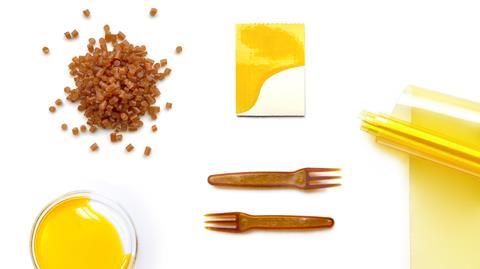
In our latest Sustainability Awards Finalist Interview, we spoke to traceless about its alternative material to bioplastics, made from agricultural plant residues and nominated in the Pre-commercialized Renewables category.
You’re a finalist in the Sustainability Awards 2023. Congratulations! To start off, could you summarise your entry, in less than 50 words?
traceless is a novel plastic alternative material that is bio-circular and uniquely sustainable. It is made from agricultural plant residues and contains 100% biobased carbon content, supporting the transition from fossils to renewables while additionally avoiding direct food conflict. Furthermore, traceless is certified home-compostable, certified plastic-free and climate-friendly.
Why do you think the judges were impressed with your entry? Tell us about what is innovative about your project and/or about its impact on packaging sustainability.
Our innovative, patented technology allows us to use food production residues to produce materials compostable under natural composting conditions for the first time. With certified 100% bio-based carbon content, traceless doesn’t cause land use change. It doesn’t need hazardous additives or solvents and has up to 95% lower CO2 emissions. Being based on natural, unmodified polymers, traceless is certified plastic-free. Already competitive to (bio)-plastics in quality, on industrial production scale our material will be price competitive to virgin plastic, allowing us to produce sustainable, affordable products for end-customers across all demographics and income levels.
At the moment, the production of many plastic alternatives relies on complex process technologies with high energy demands, often involving scarce resource materials and hazardous chemicals. In contrast, our production technology is simple, eco-friendly, toxic-free and resource efficient. traceless is the only plastic alternative on the market combining holistic impact potential, quality and price competitiveness, high scale-up potential and processability on existing plastic-converting machines.
When and how do you intend to launch/commercialize this innovation?
We are in the process of our technology scale-up, meaning traceless materials are not yet commercially available as a standard material solution. However, it is our goal to produce one million tonnes of traceless material by 2030. To achieve this, we will build a large-scale demonstration production plant with an output of several thousand tons of material per year, taking us one step closer to industrial scale production. We recently received a €5 million grant for this step from the German Federal Ministry for the Environment.
Our traceless base materials can be further processed by the plastics and composite industry into flexible films, rigid material applications, and coating and adhesive solutions. The base materials have thermoplastic characteristics, mechanical and barrier properties comparable to commonly available bioplastics, and are dyeable, printable and heat sealable. They can substitute plastic and bioplastic in a wide range of products, with packaging applications and single-use items as our first focus market sector. We aim at the field that is having both the greatest market potential and the biggest environmental impact.
Ultimately, we will sell traceless as a drop-in solution for the plastic coating, converting and packaging industries, who further produce products for the consumer-packaged goods (CPG) industry. The CPG industry has high demand for sustainable plastic substitutes - especially in applications where closed material cycles for recycling cannot be ensured, where multi-use options are not a sustainable solution, and where products are at high risk to end up in the environment.
You’re shortlisted for the pre-commercialized category for Renewable Materials. What do you see as the key demands and challenges in relation to developing new materials from renewable feedstocks for packaging applications?
Developing a new material and establishing a company around a novel technology of course comes with several challenges. For example, the scaling up of our technology from lab scale to pilot scale to industrial scale. At an industrial production level, traceless is price competitive with virgin plastics, but we are not there yet.
In the two years since our founding, we have built and commissioned a pilot plant and are currently producing our materials there. Our larger demonstration plant is being planned, while simultaneously we are working relentlessly to optimize the production process and material properties, and hereby optimizing our traceless materials for a wide range of processing technologies and product applications. Additionally, the securing of funding, building partnerships and continuously growing our team were also crucial steps in our journey so far.
What do you think are the main opportunities in this area or what future innovations do you predict in this area?
The plastics industry has played a vital role in advancing high-performance applications over the years, and we acknowledge its continued significance in these domains. However, the focus now shifts more and more towards achieving full circularity for these - and other - products. We believe this can be achieved by setting up systems for reuse, eco-design, and closed material loops.
In cases where reusable options aren’t feasible and technical recycling poses challenges, novel biomaterials like traceless step in as a compelling alternative. However, it’s crucial to emphasize that in the face of today’s environmental challenges, there’s no silver bullet to solve it all. However, with a systemic approach where many solutions complement each other, and where all stakeholders are involved, we can make an impact!
The winners of the Sustainability Awards 2023 will be announced at the Sustainable Packaging Summit, which takes place in Amsterdam on 14-15 November. The Summit mobilises leaders of the FMCG value chain, policymakers, NGOs, recyclers and investors to collaborate, remove barriers and identify opportunities on the road to sustainable transformation.
To learn more or register, visit https://www.packagingsummit.earth/amsterdam2023/.
If you liked this article, you might also enjoy:
The L’Oréal approach to packaging sustainability
What steps is Apple taking to make its packaging more sustainable?
How did Brazil achieve its 100% aluminium can recycling rate – and can it be replicated in the EU?
Experts have their say on the EU’s Packaging and Packaging Waste Directive revisions











No comments yet